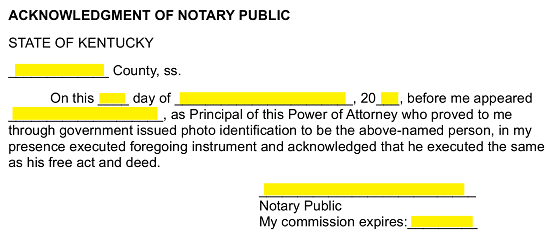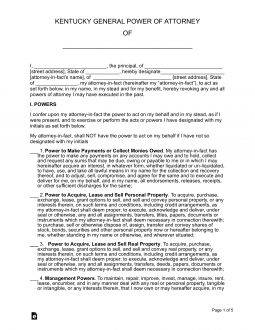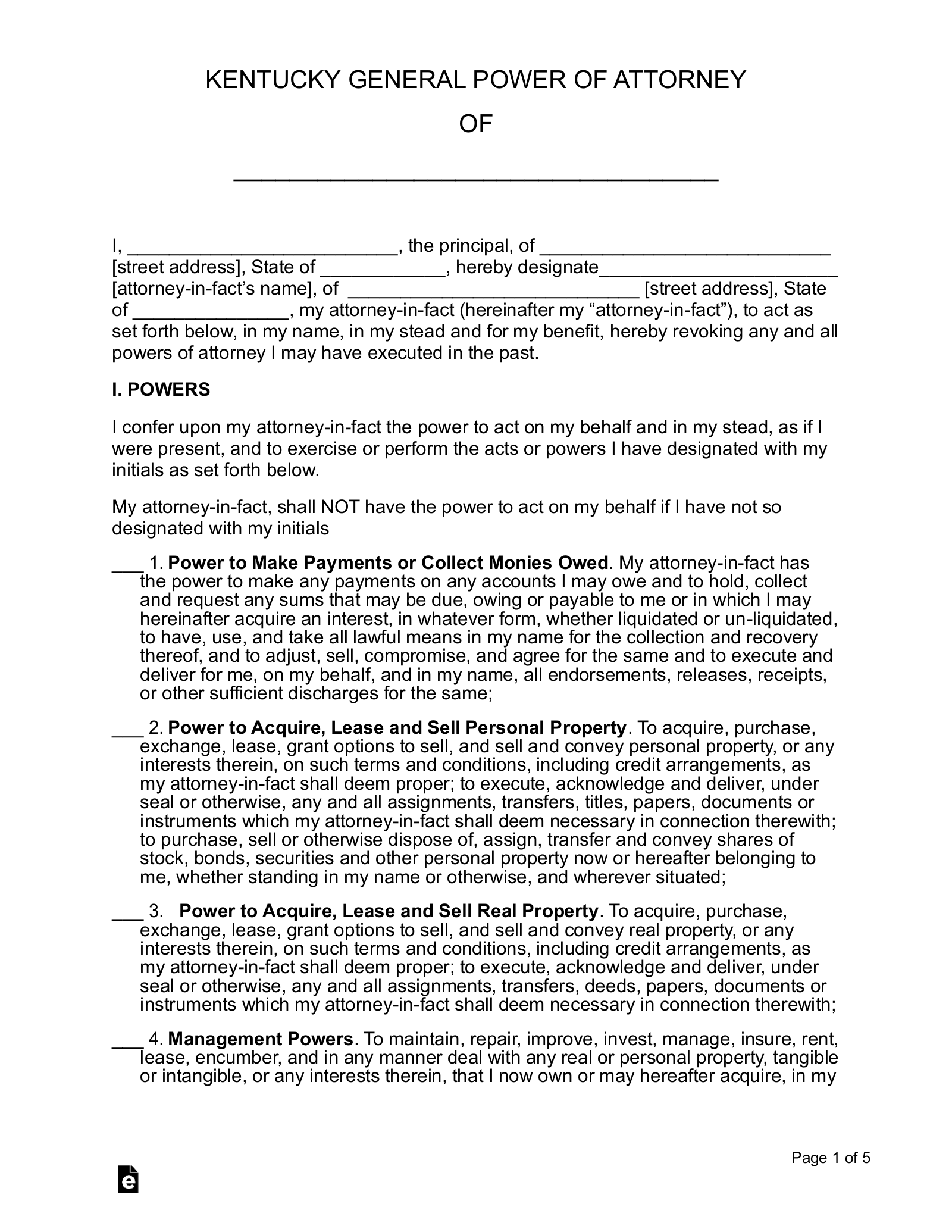Updated August 08, 2023
A Kentucky general (financial) power of attorney allows a person (the principal) to grant authority to another person (the agent) to manage their affairs. It is important the principal finds an agent they can trust implicitly, as the agent will have access and control over their financial matters. The difference between this type and the durable type is the general POA becomes void if the principal is adjudged mentally unable to make decisions for themself. If someone is looking for a POA that stays in effect beyond their incapacity, they should use the Kentucky durable POA instead.
Laws
- Statutes – Uniform Power of Attorney Act (§§ 457.010 — 457.460)
- Authority (KRS § 457.245) – An agent under a power of attorney may act on behalf of the principal and exercise broad authority as granted by the agreement.
- Signing Requirements (KRS § 457.050) – Notary Public.
How to Write
Download: PDF, MS Word, OpenDocument
Select one of the buttons describing the available file types (PDF, Word, ODT) to open this form. Once the form is open, it can be edited using a software program capable of working with the file type you downloaded or you may print it then enter information accordingly. When you are ready to enter information, supply the first blank space (in the title) with the Principal’s Legal Name.
1 – Supply The Introduction With Required Information
The Legal Name of the Principal should be supplied to the first blank space of the introduction. It should be entered precisely as it appears in the Title. 
The next two blank spaces in this paragraph should have the Principal’s Residential Street Address and the State where that Address is located filled in. Make sure to enter this information in the appropriate area.  The Attorney-in-Fact representing the Principal’s Interests by wielding the Principal’s Authority will need to have his or her Name entered on the blank space following the term “hereby designate.”
The Attorney-in-Fact representing the Principal’s Interests by wielding the Principal’s Authority will need to have his or her Name entered on the blank space following the term “hereby designate.”
Next, record the Residential Street Address and the State where the Attorney-in-Fact resides on the next two blank spaces.
2 – All Statements Defining Delegated Principal Authority Must Bear Approval Of the Principal
Once the Introduction has been tended to, it will be time to turn our attention to the types of Powers which the Principal will delegate to the Attorney-in-Fact through the Executing Principal Signature at the end of this form. The Principal will, naturally, need to make sure a clear definition of what the Attorney-in-Fact may or may not do in his or her Name has been supplied on this form before its execution. To this end, a numbered list of Statements of Authority will be presented under the heading “I. Powers.” The Principal granting Authority will need to Approve, first hand, any statement that defines the Principal Powers he or she wishes to approve and delegate to the Attorney-in-Fact.
The Principal will need to initial the blank space preceding Statement 1 to empower the Attorney-in-Fact to Make and Collect Payments using the Principal’s Authority to do so.  The second Subject of Authority will grant the Attorney-in-Fact with the Principal Approval required to Acquire, Lease, and Sell the Principal’s Personal Property in the Principal’s Name, once the blank line corresponding to this statement is initialed by the Principal.
The second Subject of Authority will grant the Attorney-in-Fact with the Principal Approval required to Acquire, Lease, and Sell the Principal’s Personal Property in the Principal’s Name, once the blank line corresponding to this statement is initialed by the Principal.  The Principal may give the Attorney-in-Fact his or her Approval to Acquire, Lease, and Sell the Principal’s Real Property at the instruction of the Principal with the same Authority the Principal holds by initialing the third Statement of Authority.
The Principal may give the Attorney-in-Fact his or her Approval to Acquire, Lease, and Sell the Principal’s Real Property at the instruction of the Principal with the same Authority the Principal holds by initialing the third Statement of Authority.  The Management Powers of the Principal may be delegated to the Attorney-in-Fact provided the Principal initials Statement Number Four.
The Management Powers of the Principal may be delegated to the Attorney-in-Fact provided the Principal initials Statement Number Four.  The Principal’s Authority in Banks and Financial Institutions will be under the Attorney-in-Fact’s Principal Powers if the Principal initials the fifth Statement of Powers.
The Principal’s Authority in Banks and Financial Institutions will be under the Attorney-in-Fact’s Principal Powers if the Principal initials the fifth Statement of Powers.  The sixth Subject of Power will define the Powers (in terms of the Principal’s Motor Vehicles) the Attorney-in-Fact may wield in the Principal’s Name if the Principal initials the sixth statement.
The sixth Subject of Power will define the Powers (in terms of the Principal’s Motor Vehicles) the Attorney-in-Fact may wield in the Principal’s Name if the Principal initials the sixth statement.  The seventh item, “Tax Powers,” shall provide a description of the actions and decisions the Attorney-in-Fact may make on behalf of the Principal with the Principal’s Tax Matters. The Principal may grant this Authority to the Attorney-in-Fact by initialing the blank space corresponding to this item.
The seventh item, “Tax Powers,” shall provide a description of the actions and decisions the Attorney-in-Fact may make on behalf of the Principal with the Principal’s Tax Matters. The Principal may grant this Authority to the Attorney-in-Fact by initialing the blank space corresponding to this item. 
The Principal will grant Access to his or her Safe-Deposit Box(es) once he or she initials Statement Number 8 If the Attorney-in-Fact will be empowered with the Principal Authority to transfer or make gifts of any kind, the Principal will need to initial the ninth item to provide clear approval.
If the Attorney-in-Fact will be empowered with the Principal Authority to transfer or make gifts of any kind, the Principal will need to initial the ninth item to provide clear approval.
The tenth Statement of Authority will allow the Attorney-in-Fact to Lend and Borrow in the Principal’s Name if the Principal initials the blank space corresponding to it.  If the Principal decides the Attorney-in-Fact should have Authority in his or her Contractual Arrangements then, he or she must initial the Statement 11.
If the Principal decides the Attorney-in-Fact should have Authority in his or her Contractual Arrangements then, he or she must initial the Statement 11. ![]() The Principal Power to take steps to gain the Principal admittance to any Health Care Facility and to view the Principal’s Medical Records will be granted to the Attorney-in-Fact once he or she initials the twelfth item.
The Principal Power to take steps to gain the Principal admittance to any Health Care Facility and to view the Principal’s Medical Records will be granted to the Attorney-in-Fact once he or she initials the twelfth item.  The Attorney-in-Fact may represent the Principal in the manner dictated by the Health Insurance Portability and Accountability Act of 1996, upon the Principal initialing the statement labeled “13. HIPAA.”
The Attorney-in-Fact may represent the Principal in the manner dictated by the Health Insurance Portability and Accountability Act of 1996, upon the Principal initialing the statement labeled “13. HIPAA.”![]() The fourteenth item will give a description of how the Attorney-in-Fact may Hire and Pay for Services in the Principal’s Name using Principal Power. If the Principal wishes to approve of such Authority that he or she must initial the blank space before the words “Power to Hire and Pay for Services.”
The fourteenth item will give a description of how the Attorney-in-Fact may Hire and Pay for Services in the Principal’s Name using Principal Power. If the Principal wishes to approve of such Authority that he or she must initial the blank space before the words “Power to Hire and Pay for Services.” If the Principal initials the item labeled “Reimbursement of Attorney-in-Fact,” he or she will grant the Attorney-in-Fact the Authority and Ability to seize reimbursement (to a reasonable extent).
If the Principal initials the item labeled “Reimbursement of Attorney-in-Fact,” he or she will grant the Attorney-in-Fact the Authority and Ability to seize reimbursement (to a reasonable extent). ![]() The Attorney-in-Fact will be empowered by the Principal to sue a third party in the Principal’s Name if that third party does not act in accordance with the Principal Power delegated to the Attorney-in-Fact by this form.
The Attorney-in-Fact will be empowered by the Principal to sue a third party in the Principal’s Name if that third party does not act in accordance with the Principal Power delegated to the Attorney-in-Fact by this form.  The last item, “17. Other,” is a tool the Principal may use to describe, deliver, and mandate Principal Preferences and Instructions to all interested entities especially the Attorney-in-Fact concerning the delegation of Authority in this form. This may range from placing restrictions on Principal Authority providing extensions to Principal Authority or even Naming specific Events or Circumstances marking when an Agent may use or may not wield Principal Authority.
The last item, “17. Other,” is a tool the Principal may use to describe, deliver, and mandate Principal Preferences and Instructions to all interested entities especially the Attorney-in-Fact concerning the delegation of Authority in this form. This may range from placing restrictions on Principal Authority providing extensions to Principal Authority or even Naming specific Events or Circumstances marking when an Agent may use or may not wield Principal Authority.
3 – The Period Of Time Defining When The Principal Authority Defined Here Is Effective
The heading “Effective Date and Termination” will contain a section where the Principal will be able to give a Start Date and Termination Date to the Powers in this document (as a whole). This will be done through the initials of the Principal placed next to the applicable statements by the Principal.
First, the Principal will declare whether the Powers in this document become effective upon his or her Signature by initialing the blank space before the words “Upon the date of this document with my authorization. If the Principal wishes the Start Date to be a specific Date, then he or she must mark the blank space with the words “The following date…” and enter the desired Start Date utilizing the blank spaces provided. 
The next set of statements the Principal must choose from will seek to define when the Principal Powers delegated to the Attorney-in-Fact should end. If the Principal wishes this paperwork’s Effective Term to end as of a specific Termination Date, the Principal should initial the first statement below the parentheses with the words “termination is effective at which of the following occurs first,” then enter the Date of termination using the appropriately placed blank spaces. If the Termination of the Attorney-in-Fact’s Principal Power will only end upon a written revocation by the Principal, the Principal will need to initial the statement beginning with the words “When I have made…” The Principal should initial the statement beginning with the words “When and if…” should he or she wish this form’s Principal Powers to terminate upon a Physician’s determination of the Principal’s incapacity.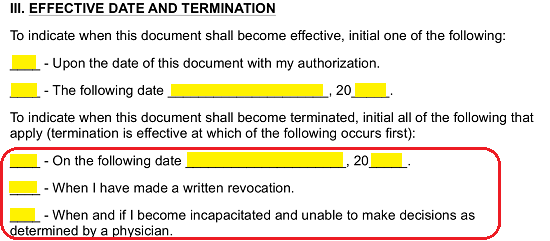
4 – The Principal May Only Expect Third-Party Reliance If Upon Several Signatures
The first sentence after the “Third Party Reliance” section will require the Signature Date for the Principal Signing of this form. This should be supplied by the Principal just before he or she provides a Signature unless a Notary Public instructs otherwise.  The next two labels, “Principal’s Signature” and “Principal’s Printed Name,” will require the Principal’s attention. Here the Principal must supply both his or her Signature as well as his or her Printed Name.
The next two labels, “Principal’s Signature” and “Principal’s Printed Name,” will require the Principal’s attention. Here the Principal must supply both his or her Signature as well as his or her Printed Name.  The next section, “Acceptance of Appointment,” requires the Printed Name of the Principal, the Attorney-in-Fact’s Signature, and the Attorney-in-Fact’s Printed Name on the three spaces here. Only the Attorney-in-Fact may satisfy the requirements of this item.
The next section, “Acceptance of Appointment,” requires the Printed Name of the Principal, the Attorney-in-Fact’s Signature, and the Attorney-in-Fact’s Printed Name on the three spaces here. Only the Attorney-in-Fact may satisfy the requirements of this item. 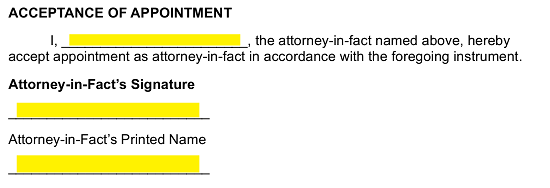 The “Acknowledgment of Notary Public” section will be filled out by the Notary Public provided each Signature Party follows this party’s instructions.
The “Acknowledgment of Notary Public” section will be filled out by the Notary Public provided each Signature Party follows this party’s instructions.